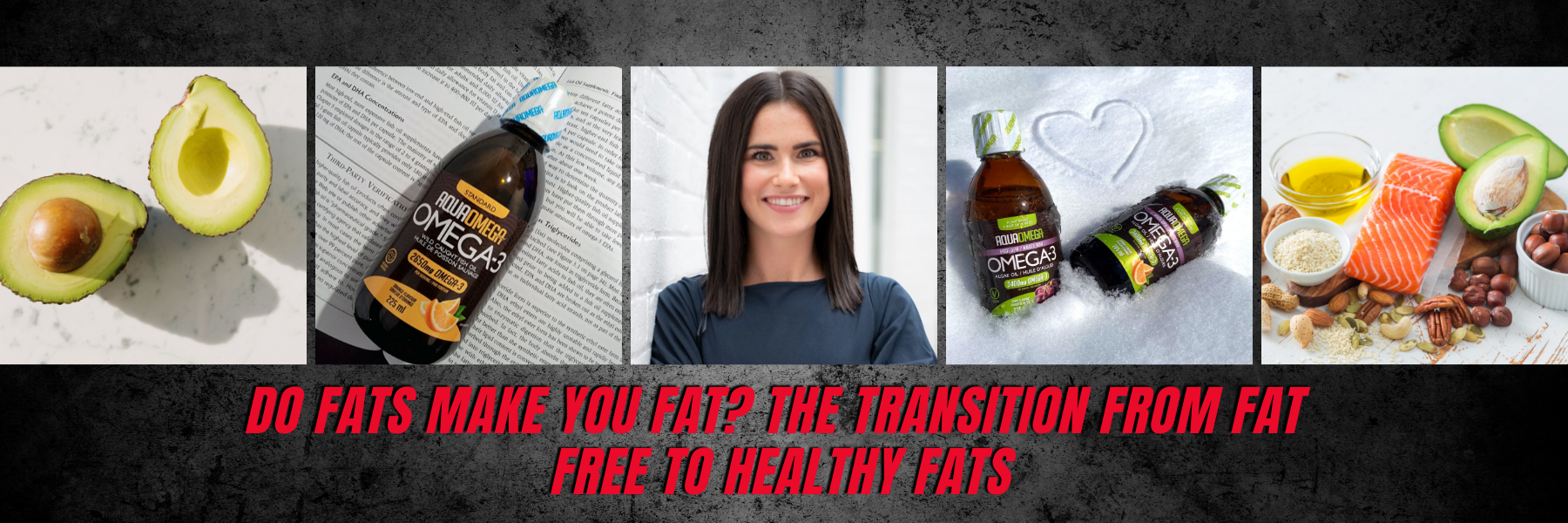
Part 2: Do fats make you fat? The transition from fat free to healthy fats
Do fats make you fat? The transition from fat free to healthy fats
Dr. Maille Devlin, ND
Most North American’s have learned to fear fat. Often, those who are looking to lower cholesterol levels or decrease weight, reach for the ‘fat free’ option. However, fat free or reduced products does not necessarily mean they will be beneficial for weight loss or cardiovascular health. In fact, these products can often make things worse.
If you are someone who seeks out low fat products to select the “healthier” option – don’t worry – you are not alone! There are several reasons we think this way. For starters, it is intuitive to think that if you eat more fat, you will accumulate fat. Secondly, the idea of using fat-free products as a healthy alternative may have been told to you by a healthcare provider who is using outdated research. Lastly, there is partial truth to the idea that fat from the diet can increase cardiovascular risk. The caveat is that the type of fat matters. Moreover, increasing certain types of fat can be protective for the heart.
The history of fat free
Let’s start by going through a brief history of the fat free movement. In the 1960s and 1970s, rates of heart disease and deaths by heart attack were increasing.1 This was around the time when diet became a treatment target. Before this, diet had not quite been connected with issues such as poor cardiovascular health.
Scientists at the time found a link between high fat foods such as diary, eggs, and meat with increased cholesterol levels in humans. This link became known as the ‘lipid hypothesis’. There was a famous study called the Seven Countries Study written by Ancel Keys.2 This study had several insightful outcomes and has helped form how we assess cardiovascular risk today. However, there were many issues with the data from this study and others including the exclusion of countries which consumed high fat diets yet had low levels of heart disease. Secondly, the studies often did not look at different sources of the saturated fat. This is very important.
Therefore, the message given at a population level was to avoid fat and instead, replace this fat with foods such as ‘heart healthy’ whole grains, fruits, and vegetables. This is where the second issue arises. Rather than emphasizing a Mediterranean-style of eating which includes high fibre, lean proteins and plenty of fruits and vegetables instead of these high fat foods; the emphasis was on avoiding the fat and replacing these with carbohydrates and polyunsaturated oils such as margarine and canola oil.
The American Heart Association and physicians across North America began to recommend the low-fat diet with the goal to reduce the likelihood of cardiovascular disease. This prompted food manufactures to switch both ingredients and marketing and cater to this new, low-fat diet trend. Butter was replaced with margarine and sugars were added to food to increase palatability. By the 1990’s fat-free salad dressing, margarine and ‘heart healthy’ cereals were in most North American households.
Fast forward to 2022 and the ending is obvious- lowering fat intake did not stop the high rates of heart disease in North America.3 In fact, while trying to lower the levels of heart disease in the population, new problems were created. Individuals were taught to fear one nutrient rather than gain an understanding of fat within context of a whole foods diet. This led to easy marketing for food companies with brands like Skittles putting ‘fat free’ on their packages. It also led to the excess intake of hyperpalatable processed foods. The idea that a low-fat snack such as a fat-free granola bar was a healthier option than an egg, led to over consumption of sugars and calories in general. Trans fats were used to create solid oils which have several well-known health implications. Inflammatory plant oils were (and still are) marketed as heart healthy and their consumption increased rapidly during this time. Sugar, flour and ‘thickeners’ are also used replace fat in products such as salad dressings and fat free yoghurts.
The results of the fat free mania can be seen in our population today. It’s important to remember that several other changes within healthcare have occurred over the years and that we cannot look at diet in isolation, we must look at it in context of other changes. However, as mentioned in the previous article, metabolic syndrome is steadily increasing each year and specifically the number of individuals with diabetes has increased dramatically and is expected to continue to rise from approximately 8.8% to 10.4% by 2040.4
The type of fat matters
Fat is a very important macronutrient. It is a fundamental aspect of organ function, nutrient absorption and storage, cell growth, immune health, reproduction and a great source of energy.
Let’s walk through the different types of fats.
Trans fats, also known as hydrogenated and partially hydrogenated oils, are normally liquid at room temperature but are hydrogenated to become semi-solid. It is in many commercially prepared baked goods and fried foods. The result is a synthetic product that has found its way into many of our foods. Look for it in ingredients lists as: hydrogenated or partially hydrogenated oil, vegetable shortening or margarine. We want to avoid trans fats. Trans fats are inflammatory, increase ‘bad’ (LDL) cholesterol levels, lower ‘good’ (HDL) cholesterol levels and are associated with heart disease. There is no debate on the health of trans fats.
Saturated fats are found mainly in animal-based foods (meats, dairy, eggs) and in a few plant-based foods (coconut oil, cocoa butter, palm oil, peanut oil). Saturated fat intake can increase risk factors for heart disease such as LDL cholesterol. However, there is not much evidence for a direct link between saturated fat intake and actual cardiovascular disease or events (heart attack and stroke).
Another important factor to look at is how the saturated fat is eaten. Having a meal of high-quality, grass-fed beef versus a McDonalds hamburger are very different sources of saturated fats. Most studies have found that the saturated fat is particularly harmful when it is paired with a higher carbohydrate pattern diet. Therefore, inflammation in the body may be more of a target than a specific type of fat in the case of saturated fat. In fact, a recent study measured the association of dietary fat and carbohydrate intake on cardiovascular events.5 The study, which followed over 135,000 individuals in 18 different countries found that a high carbohydrate intake was associated with higher risk of total mortality and a high fat diet had decreased mortality. There was no connection between fat intake and cardiovascular disease or events.5
My recommendations around saturated fat are quite individualized. Some patients do benefit from lowering intake of saturated fat while some are less sensitive. The specifics around intake for this fat will depend on personal risk factors, family history and dietary patterns. If you have cholesterol levels which are slightly increased, reducing your saturated fat intake to less than ten percent of your total dietary intake is a good place to start.
Polyunsaturated fats are considered essential fatty acids because our body cannot make them and therefore, we must consume them in our diet. Polyunsaturated fats fall can be broken down into two types: Omega 3 and Omega 6 Fats.
These fats are important for hormone regulation, growth, mood support, immune function and decreasing inflammation. The ideal ratio of Omega 6 to Omega 3 (O6:O3) should be kept around 3:1 or even 2:1. However, most North Americans currently have an O6:O3 ratio of 20:1.6 When the ratio favours the omega-6 fatty acids to this extent, there is more of a pro-inflammatory effect within the body as omega-6’s are pro inflammatory fatty acids. Therefore, the goal is to focus on foods rich in omega 3 fatty acids to help bring the ratio into balance and promote an anti-inflammatory state. This is very important for cardiovascular health. Stay tuned for the next part of the series where I will discuss the importance of these omega-3 fatty acids specifically for metabolic syndrome.
Monounsaturated fats are the types of fat often talked about in the Mediterranean Diet (i.e., olive oil). Olive oil helps to raise the “good” cholesterol (HDL) and reduce the “bad” cholesterol (LDL) and has an overall anti-inflammatory effect in the body. Other foods high in anti-inflammatory monounsaturated fats include olives, avocados, avocado oil and sesame oil. While there are other sources, including canola oil, sunflower oil, safflower oil and other vegetable oils, these oils tend to have a more pro-inflammatory effect in the body due to how they are processed. Therefore, it is recommended to reduce these oils in the diet and instead use more olive oil.
Take away
Fat is not ‘bad’. We should not fear fat, and fat can even be used as a tool in improving cardiovascular health. The type of fat that you consume matters. Additionally, never find one macronutrient to fear, instead, focus on the dietary pattern as a whole. What form of carbohydrates are you eating? What type of fat are you eating? What are you eating it with? How are you eating it? The amount and context in which you are eating certain foods matters.
Stay tuned for article 3 where I will dive into the research and use for omega-3 fatty acids for prevention and treatment of metabolic syndrome.
References
- Dalen JE, Alpert JS, Goldberg RJ, Weinstein RS. The epidemic of the 20th century: coronary heart disease. The American journal of medicine. 2014 Sep 1;127(9):807-12.
- https://www.sevencountriesstudy.com/study-findings/publications/#joint-scs
- https://www.cdc.gov/nchs/products/databriefs/db360.htm
- Saklayen MG. The global epidemic of the metabolic syndrome. Current hypertension reports. 2018 Feb;20(2):1-8.
- Dehghan M, Mente A, Zhang X, Swaminathan S, Li W, Mohan V. Associations of fats and carbohydrate intake with cardiovascular disease and mortality in 18 countries from five continents (PURE): a prospective cohort study. Lancet [Internet]. noviembre de 2017 [citado el 25 de mayo de 2019]; 390 (10107): 2050–62.
- Simopoulos AP. An increase in the omega-6/omega-3 fatty acid ratio increases the risk for obesity. Nutrients. 2016 Mar;8(3):128.
